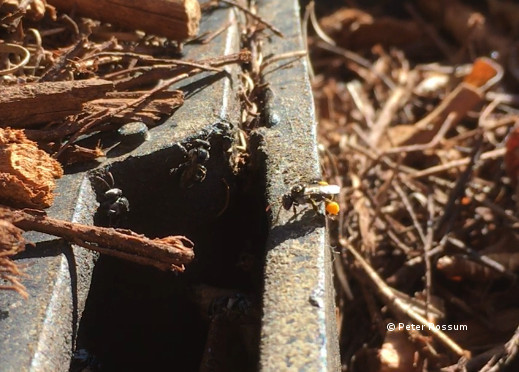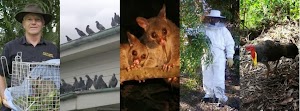There are many types of native bees in a garden in Queensland including Leaf cutter bees, Carpenter bees, Blue banded bees and even a larger Teddy bear bee.

Most of them are solitary or live in small groups and like most bees they can sting, but aren’t usually aggressive. Native stingless bees are more likely to be noticed because they do live in large colonies. On a warm summer’s day will be very busy collecting nectar and pollen.
Their nest is often hidden in a hollow in a tree but sometimes they use cavities in the walls of a house or a water meter box. They are quite small (only 3-5 mm long) and black. They could be mistaken for flying ants or flies. Like all native bees they fill an important role fertilising native plants and our garden flowers.
The most common species around Brisbane are Tetragonula carbonaria and Tetragonula hockingsi. You can go very close to the entrance to their hives and they will ignore you and of course cannot sting. So why not take the time to observe them? Only if their nest is disturbed will they try to bite but it’s a very small nip and they don’t have any venom. If annoyed they will land in your eyes and nose to try and defend their hive. Children can find them interesting to watch.
In the same way as the much larger honey bee, they will do a dance at the hive entrance to tell other bees where to find some food or water. Foraging bees returning to the nest can be seen with sacs on their legs loaded with either nectar or pollen. At the hive entrance there are guard bees. These guards check the returning foragers and watch out for intruders which include some other insects and parasitic wasps. Those intruders want to enter the hive to steal honey or lay their own eggs.
A larger hive might have a few thousand individuals; so there is a lot of activity at the entrance. Eventually their nest cavity may be completely filled with a comb containing honey pots, other spherical storage pots for pollen, stores of plant resins and a central brood chamber with all the developing eggs.
The honey and pollen are stored in small spheres made from plant resins that look like bunches of tiny brown grapes. Each native bee colony member has a role either caring for the eggs, cleaning the nest, or later in life, going outside to forage for food. If there is a lack of space to expand, they will send off half of the workers with a new queen. When that happens, you may notice a cloud of stingless bees flying around as they search for a new location. Even then they are harmless and it is quite safe to walk through the swarm. If one settles on you, it is easy to see how it is a miniature, black version of a honey bee. It may tickle as it investigates your skin before flying off.
If you need any assistance with native bees give us a call.







